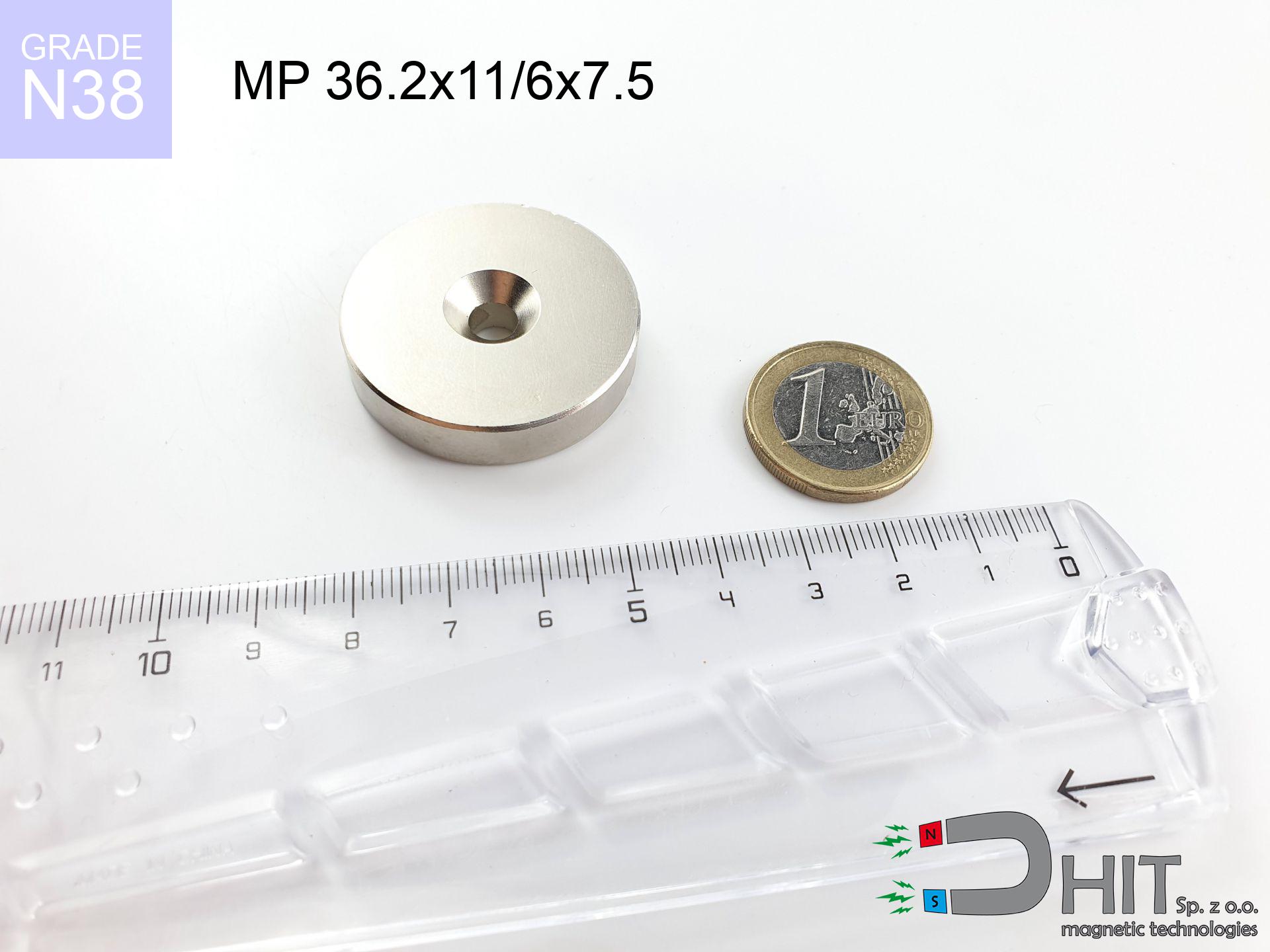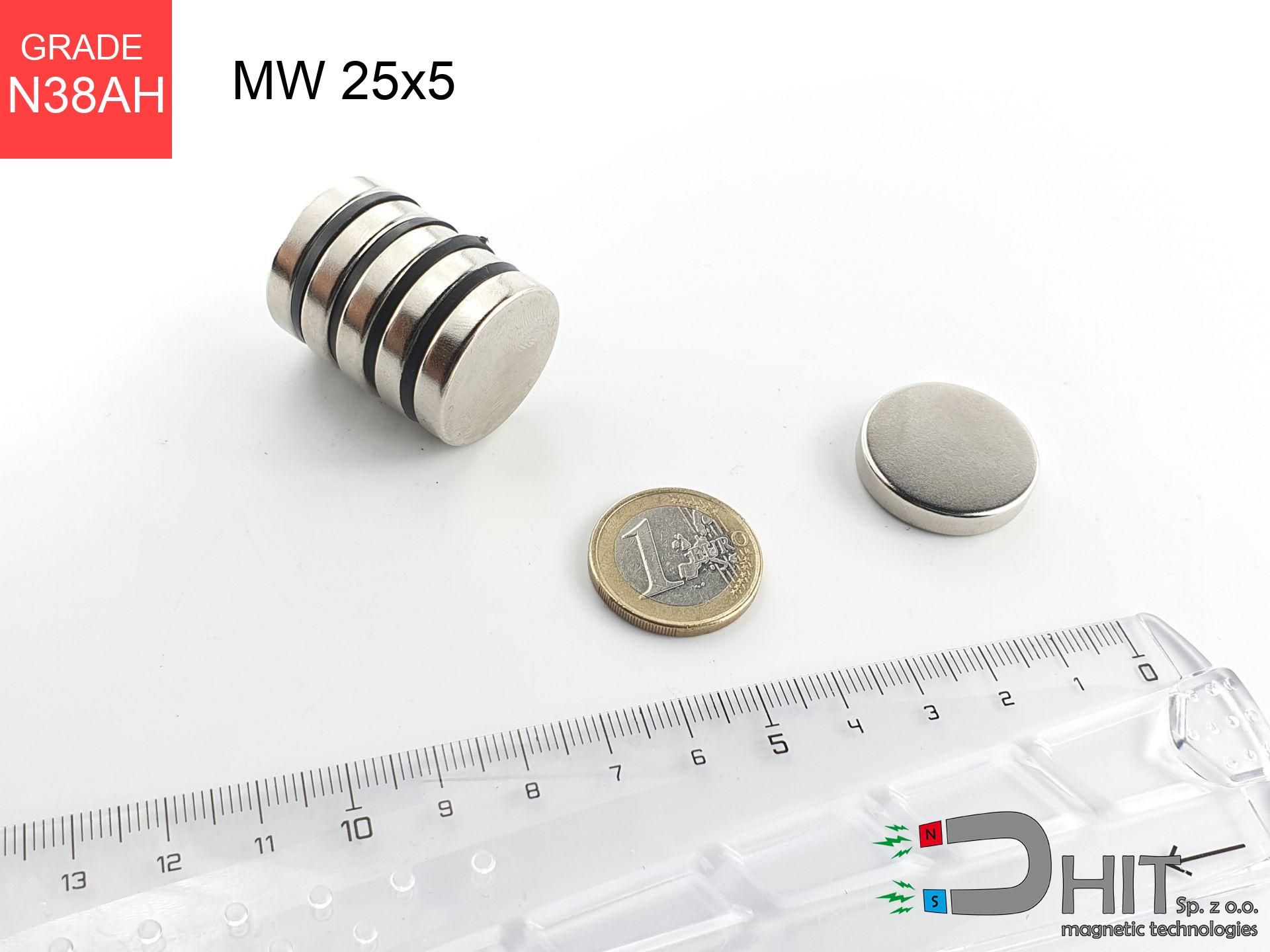UMGZ 16x13x5 [M4] GZ / N38 - magnetic holder external thread
magnetic holder external thread
Catalog no 190321
GTIN/EAN: 5906301813804
Diameter Ø
16 mm [±1 mm]
Height
13 mm [±1 mm]
Height
5 mm [±1 mm]
Weight
7 g
Load capacity
5.00 kg / 49.03 N
3.89 ZŁ with VAT / pcs + price for transport
3.16 ZŁ net + 23% VAT / pcs
bulk discounts:
Need more?
Call us
+48 888 99 98 98
alternatively get in touch by means of
request form
our website.
Weight and appearance of magnets can be estimated with our
magnetic calculator.
Same-day shipping for orders placed before 14:00.
Technical specification of the product - UMGZ 16x13x5 [M4] GZ / N38 - magnetic holder external thread
Specification / characteristics - UMGZ 16x13x5 [M4] GZ / N38 - magnetic holder external thread
| properties | values |
|---|---|
| Cat. no. | 190321 |
| GTIN/EAN | 5906301813804 |
| Production/Distribution | Dhit sp. z o.o. |
| Country of origin | Poland / China / Germany |
| Customs code | 85059029 |
| Diameter Ø | 16 mm [±1 mm] |
| Height | 13 mm [±1 mm] |
| Height | 5 mm [±1 mm] |
| Weight | 7 g |
| Load capacity ~ ? | 5.00 kg / 49.03 N |
| Manufacturing Tolerance | ±1 mm |
Magnetic properties of material N38
| properties | values | units |
|---|---|---|
| remenance Br [min. - max.] ? | 12.2-12.6 | kGs |
| remenance Br [min. - max.] ? | 1220-1260 | mT |
| coercivity bHc ? | 10.8-11.5 | kOe |
| coercivity bHc ? | 860-915 | kA/m |
| actual internal force iHc | ≥ 12 | kOe |
| actual internal force iHc | ≥ 955 | kA/m |
| energy density [min. - max.] ? | 36-38 | BH max MGOe |
| energy density [min. - max.] ? | 287-303 | BH max KJ/m |
| max. temperature ? | ≤ 80 | °C |
Physical properties of sintered neodymium magnets Nd2Fe14B at 20°C
| properties | values | units |
|---|---|---|
| Vickers hardness | ≥550 | Hv |
| Density | ≥7.4 | g/cm3 |
| Curie Temperature TC | 312 - 380 | °C |
| Curie Temperature TF | 593 - 716 | °F |
| Specific resistance | 150 | μΩ⋅cm |
| Bending strength | 250 | MPa |
| Compressive strength | 1000~1100 | MPa |
| Thermal expansion parallel (∥) to orientation (M) | (3-4) x 10-6 | °C-1 |
| Thermal expansion perpendicular (⊥) to orientation (M) | -(1-3) x 10-6 | °C-1 |
| Young's modulus | 1.7 x 104 | kg/mm² |
Material specification
| iron (Fe) | 64% – 68% |
| neodymium (Nd) | 29% – 32% |
| boron (B) | 1.1% – 1.2% |
| dysprosium (Dy) | 0.5% – 2.0% |
| coating (Ni-Cu-Ni) | < 0.05% |
Ecology and recycling (GPSR)
| recyclability (EoL) | 100% |
| recycled raw materials | ~10% (pre-cons) |
| carbon footprint | low / zredukowany |
| waste code (EWC) | 16 02 16 |
Other offers
Strengths and weaknesses of rare earth magnets.
Strengths
- They retain magnetic properties for almost ten years – the loss is just ~1% (based on simulations),
- They show high resistance to demagnetization induced by external magnetic fields,
- A magnet with a smooth silver surface has better aesthetics,
- They show high magnetic induction at the operating surface, making them more effective,
- Due to their durability and thermal resistance, neodymium magnets can operate (depending on the shape) even at high temperatures reaching 230°C or more...
- Due to the ability of precise molding and adaptation to individualized projects, neodymium magnets can be manufactured in a variety of forms and dimensions, which increases their versatility,
- Significant place in innovative solutions – they find application in hard drives, drive modules, diagnostic systems, and industrial machines.
- Thanks to their power density, small magnets offer high operating force, in miniature format,
Disadvantages
- Brittleness is one of their disadvantages. Upon intense impact they can break. We recommend keeping them in a steel housing, which not only secures them against impacts but also raises their durability
- Neodymium magnets demagnetize when exposed to high temperatures. After reaching 80°C, many of them experience permanent weakening of strength (a factor is the shape as well as dimensions of the magnet). We offer magnets specially adapted to work at temperatures up to 230°C marked [AH], which are extremely resistant to heat
- When exposed to humidity, magnets usually rust. For applications outside, it is recommended to use protective magnets, such as those in rubber or plastics, which prevent oxidation as well as corrosion.
- Limited possibility of producing threads in the magnet and complicated forms - preferred is a housing - magnetic holder.
- Possible danger resulting from small fragments of magnets pose a threat, when accidentally swallowed, which becomes key in the context of child health protection. Furthermore, tiny parts of these magnets can be problematic in diagnostics medical after entering the body.
- High unit price – neodymium magnets are more expensive than other types of magnets (e.g. ferrite), which hinders application in large quantities
Holding force characteristics
Highest magnetic holding force – what affects it?
- on a plate made of mild steel, perfectly concentrating the magnetic field
- whose thickness is min. 10 mm
- characterized by lack of roughness
- under conditions of no distance (metal-to-metal)
- during pulling in a direction vertical to the mounting surface
- in neutral thermal conditions
Lifting capacity in real conditions – factors
- Space between surfaces – even a fraction of a millimeter of distance (caused e.g. by veneer or unevenness) diminishes the pulling force, often by half at just 0.5 mm.
- Force direction – note that the magnet has greatest strength perpendicularly. Under sliding down, the capacity drops significantly, often to levels of 20-30% of the nominal value.
- Metal thickness – the thinner the sheet, the weaker the hold. Part of the magnetic field penetrates through instead of generating force.
- Material type – the best choice is pure iron steel. Hardened steels may have worse magnetic properties.
- Plate texture – ground elements ensure maximum contact, which increases field saturation. Rough surfaces reduce efficiency.
- Thermal conditions – neodymium magnets have a sensitivity to temperature. When it is hot they lose power, and in frost gain strength (up to a certain limit).
Lifting capacity testing was performed on a smooth plate of optimal thickness, under a perpendicular pulling force, whereas under parallel forces the lifting capacity is smaller. In addition, even a slight gap between the magnet and the plate decreases the holding force.
Warnings
Life threat
Life threat: Strong magnets can deactivate pacemakers and defibrillators. Do not approach if you have electronic implants.
Physical harm
Watch your fingers. Two powerful magnets will snap together immediately with a force of massive weight, crushing anything in their path. Be careful!
Allergy Warning
Allergy Notice: The Ni-Cu-Ni coating contains nickel. If skin irritation happens, immediately stop working with magnets and use protective gear.
Swallowing risk
NdFeB magnets are not suitable for play. Swallowing several magnets can lead to them pinching intestinal walls, which poses a direct threat to life and requires urgent medical intervention.
Powerful field
Be careful. Neodymium magnets attract from a long distance and connect with huge force, often quicker than you can move away.
Magnet fragility
Neodymium magnets are ceramic materials, which means they are very brittle. Impact of two magnets will cause them cracking into small pieces.
Data carriers
Do not bring magnets near a purse, laptop, or TV. The magnetism can irreversibly ruin these devices and erase data from cards.
Impact on smartphones
A strong magnetic field interferes with the operation of magnetometers in phones and GPS navigation. Keep magnets close to a device to avoid breaking the sensors.
Maximum temperature
Monitor thermal conditions. Heating the magnet above 80 degrees Celsius will permanently weaken its properties and strength.
Dust explosion hazard
Fire hazard: Neodymium dust is highly flammable. Avoid machining magnets in home conditions as this risks ignition.

![Magnet with screw UMGZ 16x13x5 [M4] GZ / N38 Magnet with screw UMGZ 16x13x5 [M4] GZ / N38](https://cdn3.dhit.pl/graphics/banners/magnet.webp)
![UMGZ 16x13x5 [M4] GZ / N38 - magnetic holder external thread](https://cdn3.dhit.pl/graphics/products/um-16x13x5-m4-gz-cor.jpg)
![UMGZ 16x13x5 [M4] GZ / N38 - magnetic holder external thread - ujęcie 2](https://cdn3.dhit.pl/graphics/products/umgw-16x13x5-m4-gz-vuz.jpg)
![SM 25x100 [2xM8] / N52 - magnetic separator SM 25x100 [2xM8] / N52 - magnetic separator](https://cdn3.dhit.pl/graphics/products/sm-25x100-2xm8-fin.jpg)




